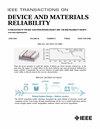Exploring the Optimal Solution for Graphene-Based Microstrip Line Attenuators
IF 2.3
3区 工程技术
Q2 ENGINEERING, ELECTRICAL & ELECTRONIC
IEEE Transactions on Device and Materials Reliability
Pub Date : 2025-06-09
DOI:10.1109/TDMR.2025.3578061
引用次数: 0
Abstract
This study explores optimization strategies for the attenuation performance and modulation depth of Graphene-based Microstrip Line Attenuators (GMSLAs). Existing GMSLAs mainly rely on rectangular attenuation units, such as single-layer graphene sheets and graphene composite sandwich structures, which have limitations in meeting diverse performance requirements. To address this, this study systematically investigates which configuration within the same class of structures yields the most optimal and reliable attenuation performance. Using finite element simulations, this study systematically examines the attenuation performance and modulation characteristics of graphene ring-shaped attenuation units with five distinct geometric configurations (circle, regular triangle, square, regular pentagon, and regular hexagon) in the 40-70 GHz V-band. The results indicate that among individual units, the hexagonal unit exhibits the highest average reflection transmission loss and modulation depth. The triangular unit demonstrates a relatively stable and high average reflection transmission loss as well as the most stable modulation depth, whereas the square unit possesses the most stable average reflection transmission loss. Furthermore, by adjusting the rotation angle of the hexagonal units, significant polarization-dependent attenuation was observed. When combining multiple hexagonal units, their performance exceeded the simple sum of individual unit performances, showing superlinear growth. This study overcomes the limitations of traditional graphene attenuation unit designs by introducing a range of geometric configurations, offering new insights into the development of highly efficient, tunable attenuators with superior performance in high-frequency bands.探索基于石墨烯微带线衰减器的最佳解决方案
本研究探讨了石墨烯基微带线衰减器(GMSLAs)衰减性能和调制深度的优化策略。现有的GMSLAs主要依赖于矩形衰减单元,如单层石墨烯片和石墨烯复合夹层结构,在满足多种性能要求方面存在局限性。为了解决这个问题,本研究系统地调查了同一类结构中哪种配置产生最优和最可靠的衰减性能。利用有限元模拟技术,系统研究了40-70 GHz v波段具有圆形、正三角形、正方形、正五边形和正六边形五种不同几何构型的石墨烯环形衰减单元的衰减性能和调制特性。结果表明,在单个单元中,六边形单元的平均反射透射损耗和调制深度最高。三角形单元具有相对稳定的高平均反射传输损耗和最稳定的调制深度,而正方形单元具有最稳定的平均反射传输损耗。此外,通过调整六边形单元的旋转角度,可以观察到明显的偏振相关衰减。当多个六边形单元组合时,它们的性能超过单个单元性能的简单总和,呈现出超线性增长。本研究通过引入一系列几何结构,克服了传统石墨烯衰减单元设计的局限性,为在高频波段具有卓越性能的高效可调谐衰减器的开发提供了新的见解。
本文章由计算机程序翻译,如有差异,请以英文原文为准。
求助全文
约1分钟内获得全文
求助全文
来源期刊

IEEE Transactions on Device and Materials Reliability
工程技术-工程:电子与电气
CiteScore
4.80
自引率
5.00%
发文量
71
审稿时长
6-12 weeks
期刊介绍:
The scope of the publication includes, but is not limited to Reliability of: Devices, Materials, Processes, Interfaces, Integrated Microsystems (including MEMS & Sensors), Transistors, Technology (CMOS, BiCMOS, etc.), Integrated Circuits (IC, SSI, MSI, LSI, ULSI, ELSI, etc.), Thin Film Transistor Applications. The measurement and understanding of the reliability of such entities at each phase, from the concept stage through research and development and into manufacturing scale-up, provides the overall database on the reliability of the devices, materials, processes, package and other necessities for the successful introduction of a product to market. This reliability database is the foundation for a quality product, which meets customer expectation. A product so developed has high reliability. High quality will be achieved because product weaknesses will have been found (root cause analysis) and designed out of the final product. This process of ever increasing reliability and quality will result in a superior product. In the end, reliability and quality are not one thing; but in a sense everything, which can be or has to be done to guarantee that the product successfully performs in the field under customer conditions. Our goal is to capture these advances. An additional objective is to focus cross fertilized communication in the state of the art of reliability of electronic materials and devices and provide fundamental understanding of basic phenomena that affect reliability. In addition, the publication is a forum for interdisciplinary studies on reliability. An overall goal is to provide leading edge/state of the art information, which is critically relevant to the creation of reliable products.
 求助内容:
求助内容: 应助结果提醒方式:
应助结果提醒方式:


